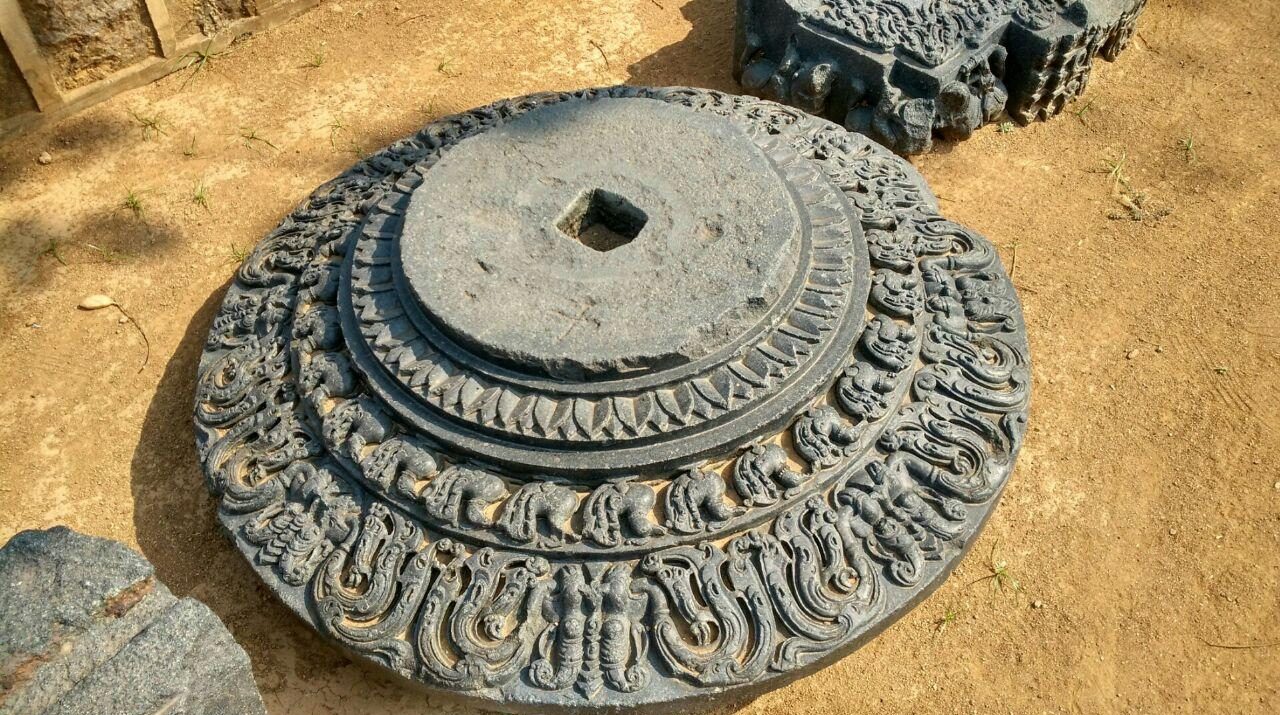#Didyouknow that the month of Ashwin in the Hindu calendar is the month of the Goddess or devi ?
The fervour can be felt all over India with Durga images everywhere. She is worshipped as Ma Durga or Durga Mata. There are different legends associated with her. In Bengal she is believed to come home from the mountains with her children and is worshipped with them alongside with great pomp and festivity !
The concept of devi first appeared in the Vedas in 200 B.C. but gained focus in Puranic literature with texts like the Devi Mahatmya. Goddess Durga reigns supreme and is the divine feminine as Devi in Hinduism and a divine mother as Mata. Taken from the Devi Mahatmyam – the story goes thus – Durga as Mahisasuramardini is one of the manifestations of the Divine mother whose primary aim is to combat demons who threaten the cosmos. She has many arms and each has a different weapon. She rides on a lion and defeats the buffalo demon Mahisasura who has been given a boon that no-one can defeat him except a woman. The demon’s entire army was challenged by Durga. Mahisasura attacked Durga as a buffalo-demon whom Durga kills with a trisula (trident) after a fierce battle. Feast your eyes on some awesome images done in the traditional Madhubani style of painting !

Durga slays Mahisasura, Madhubani painting.
The images depicted here are of Goddess Durga from the Mithila school of painting, originated mostly in North Bihar of India which mostly depict religious stories in painting. It is called commonly called Madhubani painting which is made mostly by women. Madhubani art is being created since many centuries in some parts of Bihar, in fact there is no concrete evidence as to when it actually began. The art got national recognition when artists like Jagadamba Devi, Sita Devi were given National awards by the President of India. This art form is well-liked by the European and Canadian people among others. The exhibition Expo 70 in Japan and Asia-72 further established this art form ensuring sales of the paintings, which were made on other media like paper, instead of the regular floor or walls of the villages. The art has become more visible and popular once it has come on to paper. Now one gets to see the art form on sarees, trains, picture galleries, five star hotels, walls of railway stations and private drawing rooms. However as noted by Indian historian Upendra Thakur in his monumental work, the art needs to be constantly protected from gross commercialisation.
Madhubani paintings have many colour settings. Deep red, green, blue, black,light yellow, pink etc. Red is dominant in many paintings. A bamboo twig is used for drawing outlines. For filling colour pihua, a small piece of cloth tied to a twig is used. Women gather together and make the painting. A leader among them draws the composition and others fill colour. Younger girls assist the older women. Families keep paper notes of the artwork, to be made during ceremonies. It is even shared with the same caste from different villages. The styles get repeated but with variations, though the idioms remain the same.

Durga slays Mahisasura, Madhubani painting.
Goddess Durga is a favourite deity. Goddess Kali is an important deity in Tantrik rituals and tantra has had an important effect in the making of Aripana (floor drawings) and wall paintings. The major motifs in Madhubani painting depict flora, fauna, natural life. Gods, goddesses, lion, fish, parrot, turtle, bamboo, lotus, creepers, swastika among others. These forms are interchangeably used as per the ritual. Events like the thread ceremony, initial wedding formalities, final wedding rites, renovation of shrine all demand paintings. Paintings are made for both beautification and sanctification of the courtyard and threshold. Kohabara paintings augment well for the marriage. The kadamba tree, sun, flowers, peacocks, moon, palanquin, tortoise, fish are all depicted. Bhitti chitra or wall paintings are drawn on auspicious occasions. Symbols used in Madhubani painting have their own significance. Elephant, palanquin denote royalty. Sun and moon represent long life. Goose and peacock are symbols of welfare and calmness. Lotus denotes good luck the bamboo denotes future progeny.
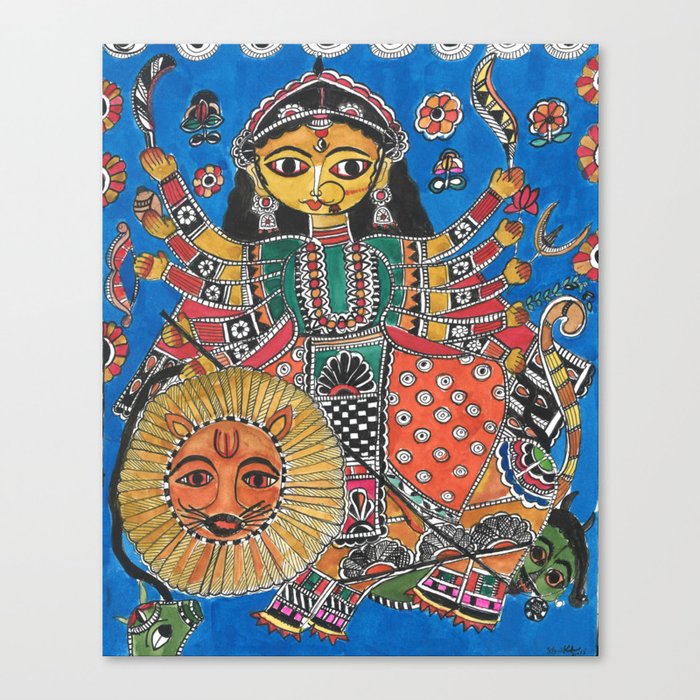
Durga slays Mahisasura, Madhubani painting.
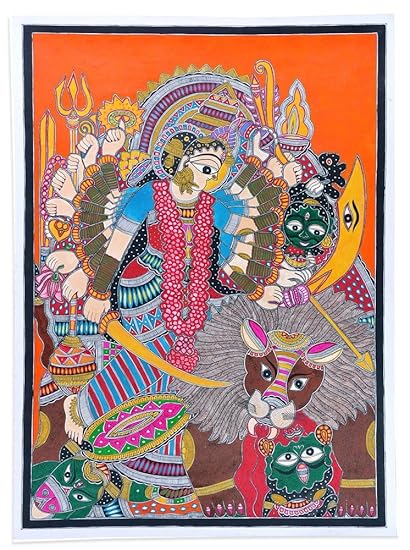
Durga slays Mahisasura, Madhubani painting.
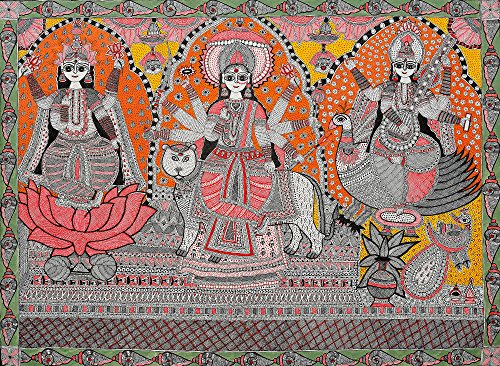
Durga with Lakshmi and Saraswati, Madhubani painting.
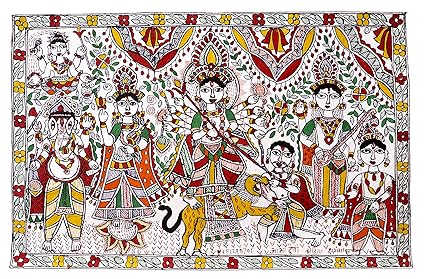
Durga with Lakhsmi, Saraswati, Ganesh and Kartik, Madhubani painting.

Durga slays Mahisasura, Madhubani painting.
References :
- Marg : a magazine of architecture and art Vol 3, No 3, Bombay : Marg Publications, 1949.
- Madhubani painting/Thakur, Upendra, New Delhi : Abhinav Publications, 1981
- Madhubani painting/Ananad, Mulk Raj, New Delhi : Publications Division, 1984.
- Madhubani art /Dayal, Bharti, New Delhi : Niyogi Books, 2016.
- Images are from Wikimedia Commons and Amazon.in
Posted by :
Soma Ghosh
©author
